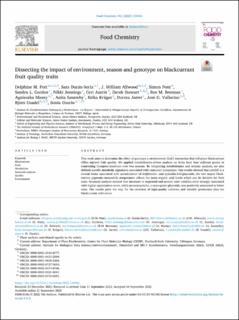Dissecting the impact of environment, season and genotype on blackcurrant fruit quality traits.
| dc.contributor.author | Pott, D. M. | |
| dc.contributor.author | Duran-Soria, S. | |
| dc.contributor.author | Allwood, J. W. | |
| dc.contributor.author | Pont, S. | |
| dc.contributor.author | Gordon, S. L. | |
| dc.contributor.author | Jennings, N. | |
| dc.contributor.author | Austin, C. | |
| dc.contributor.author | Stewart, D. | |
| dc.contributor.author | Brennan, R. M. | |
| dc.contributor.author | Masny, A. | |
| dc.contributor.author | Sønsteby, Anita | |
| dc.contributor.author | Krüger, Erika | |
| dc.contributor.author | Jarret, D. | |
| dc.contributor.author | Vallarino, J. G. | |
| dc.contributor.author | Usadel, B. | |
| dc.contributor.author | Osorio, S. | |
| dc.date.accessioned | 2023-04-03T12:41:59Z | |
| dc.date.available | 2023-04-03T12:41:59Z | |
| dc.date.created | 2022-12-22T09:30:43Z | |
| dc.date.issued | 2022-10-08 | |
| dc.identifier.citation | Pott, D. M., Durán-Soria, S., Allwood, J. W., Pont, S., Gordon, S. L., Jennings, N., Austin, C., Stewart, D., Brennan, R. M., Masny, A., Sønsteby, A., Krüger, E., Jarret, D., Vallarino, J. G., Usadel, B., & Osorio, S. (2023). Dissecting the impact of environment, season and genotype on blackcurrant fruit quality traits. Food Chemistry, 402, 134360. | en_US |
| dc.identifier.issn | 0308-8146 | |
| dc.identifier.uri | https://hdl.handle.net/11250/3061853 | |
| dc.description.abstract | This work aims to determine the effect of genotype x environment (GxE) interaction that influence blackcurrant (Ribes nigrum) fruit quality. We applied metabolomics-driven analysis on fruits from four cultivars grown in contrasting European-locations over two seasons. By integrating metabolomics and sensory analysis, we also defined specific metabolic signatures associated with consumer acceptance. Our results showed that rainfall is a crucial factor associated with accumulation of delphinidin- and cyanidin-3-O-glucoside, the two mayor blackcurrant pigments meanwhile temperature affects the main organic acid levels which can be decisive for fruit taste. Sensorial analysis showed that increases in terpenoid and acetate ester volatiles were strongly associated with higher appreciation score, while proacacipetalin, a cyanogenic-glycoside, was positively associated to bitter taste. Our results pave the way for the selection of high-quality cultivars and suitable production sites for blackcurrant cultivation. | en_US |
| dc.language.iso | eng | en_US |
| dc.publisher | Elsevier Ltd. | en_US |
| dc.rights | Attribution-NonCommercial-NoDerivatives 4.0 Internasjonal | * |
| dc.rights.uri | http://creativecommons.org/licenses/by-nc-nd/4.0/deed.no | * |
| dc.title | Dissecting the impact of environment, season and genotype on blackcurrant fruit quality traits. | en_US |
| dc.title.alternative | Dissecting the impact of environment, season and genotype on blackcurrant fruit quality traits. | en_US |
| dc.type | Peer reviewed | en_US |
| dc.type | Journal article | en_US |
| dc.description.version | publishedVersion | en_US |
| dc.rights.holder | © 2022 The Authors | en_US |
| dc.source.volume | 402 | en_US |
| dc.source.journal | Food Chemistry | en_US |
| dc.identifier.doi | 10.1016/j.foodchem.2022.134360 | |
| dc.identifier.cristin | 2096757 | |
| dc.relation.project | EC/H2020/679303 | en_US |
| dc.source.articlenumber | 134360 | en_US |
| cristin.ispublished | true | |
| cristin.fulltext | original | |
| cristin.qualitycode | 1 |
Files in this item
This item appears in the following Collection(s)
-
Divisjon for matproduksjon og samfunn [1028]
Publikasjoner knyttet til ansatte ved Divisjon for matproduksjon og samfunn -
Publikasjoner fra CRIStin - NIBIO [4554]
-
Vitenskapelige artikler [1416]

